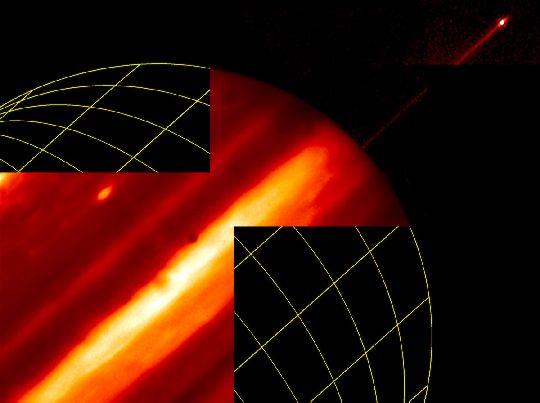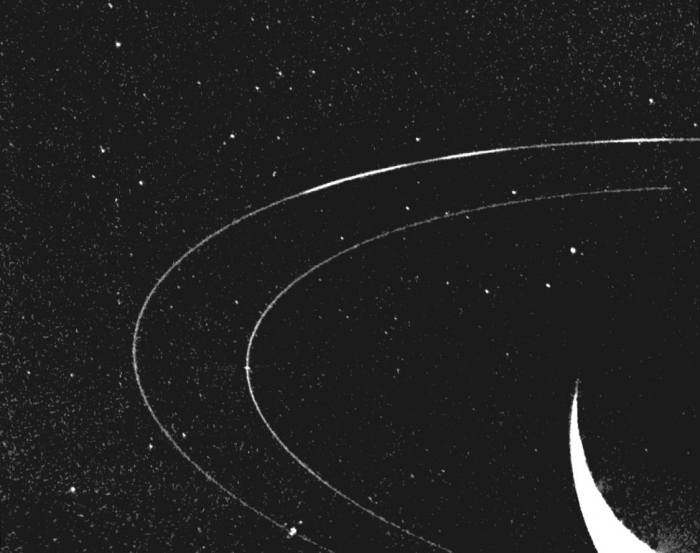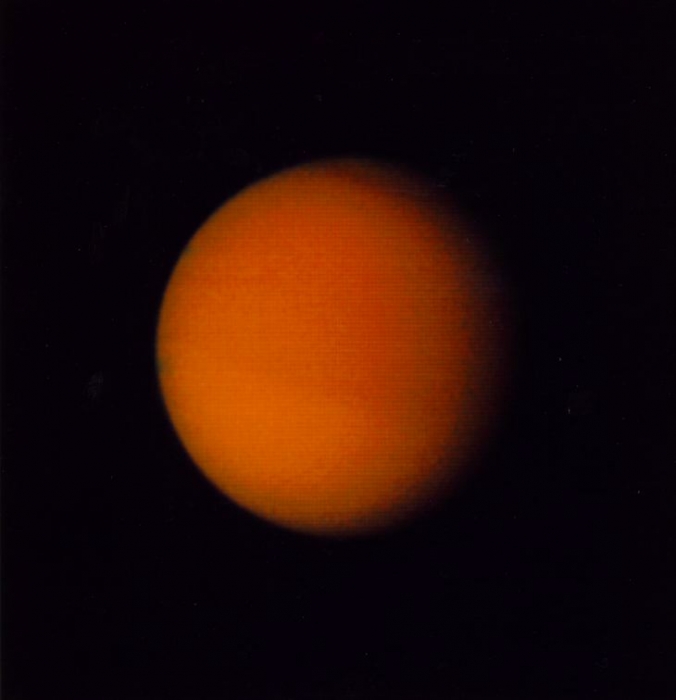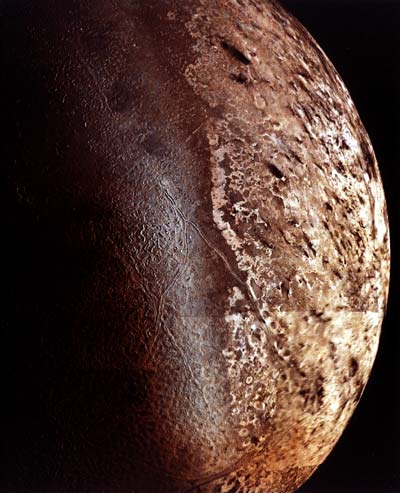Additional reading from www.astronomynotes.com
Ring systems
Saturn is the only gas giant planet that has a prominent, easily observable ring system. However, observations have revealed that each of the Jovian planets have ring systems. Jupiter's ring is exceptionally faint. The particles in Jupiter's ring are smaller than those in Saturn's rings and do not reflect light as well.
Uranus also has rings, and the images that reveal its rings emphasize how tilted this planet is compared to Saturn. The images show that the rings appear vertical, while those in Saturn are horizontal. Like Jupiter, the particles in the rings of Uranus are smaller than those in Saturn's rings. They also do not reflect light well. In the case of Jupiter and Uranus, our physical models suggest that the particles should not be able to remain in the rings very long, thus the rings should dissolve over time. Therefore, we suspect that the ring systems of the giant planets may be relatively young—only a few hundred million years old—compared to the nearly 5 billion-year-old age of the planets themselves.
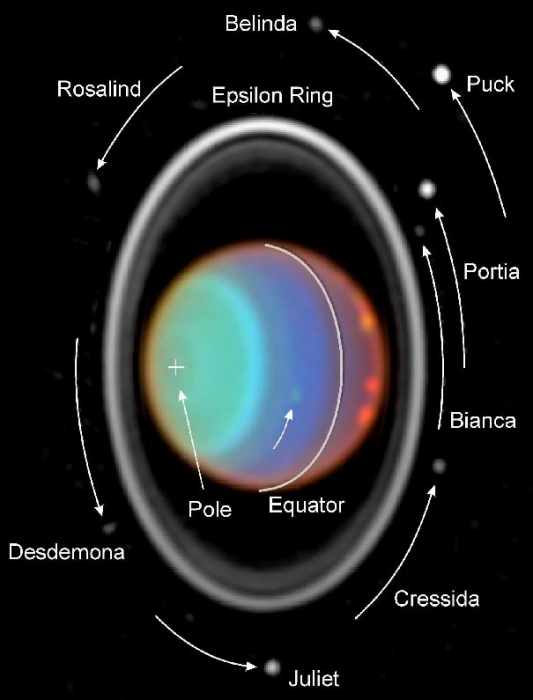
Neptune also has a ring system, but it is not as well observed as those of the other planets. It appears to also contain dust grain-sized particles, but one peculiarity is that its rings are more "clumpy" than those of the other gas giant planets.
Jupiter's moons
Each of the gas giant planets can be thought of as its own mini version of the Solar System. Each planet has a large system of moons which are in orbit around it. Jupiter has more than 60 moons, Saturn has more than 30, Uranus more than 20, and Neptune more than 10.
Exactly how many moons does each Jovian planet have?
When asked this question, I do not often quote a firm number of moons, because astronomers continue to find more. Instead, I usually simply say, for example, that Jupiter has more than 60 moons.
An example of a moon discovered recently (although it is associated with Saturn, not Jupiter) is found in a press release from the NASA Cassini mission. Much more recently, some of Jupiter's "lost" moons were found again, and two new ones were discovered. Jupiter is now inching closer to 70 moons.
The four biggest moons of Jupiter are famous in the field of astronomy because they were part of the revolution to a heliocentric understanding of the Solar System. If you recall back in the earliest lessons in this course, we studied that the ancient astronomers believed that the Earth was the center of the Universe and that all objects (the Sun, the planets, the stars) orbit the Earth. When Jupiter was first observed through a telescope by Galileo, he discovered four moons orbiting this planet, which was evidence that not every object orbited the Earth. This important observation was very influential in the debate over the heliocentric vs. geocentric models of the Solar System.
In modern times, we have observed these four moons in detail, because they are by far the largest of Jupiter's moons and each one has its own interesting properties. They are classified as moons because they orbit Jupiter, but these objects are so large that if they were to orbit the Sun on their own, they might be called planets. The four Galilean moons of Jupiter are called Io, Europa, Ganymede, and Callisto. Their properties are briefly described below, followed by links to images highlighting specific features of those moons.
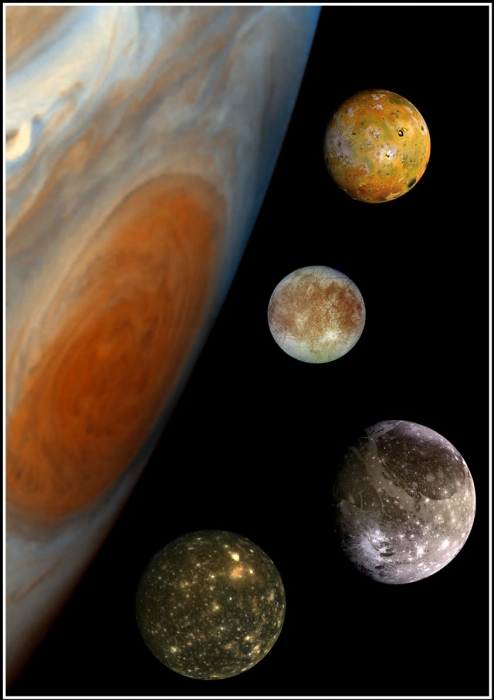
- Io: The innermost of Jupiter's Galilean Moons is very active. Because of the constant deforming of the surface of this Moon by Jupiter's tidal force, the interior of Io is continuously heated, which leads to many active volcanoes on its surface. The moon has over 100 volcanoes that erupt frequently and constantly alter the surface of this moon. Io, therefore, has the youngest surface of any solar system object.
- Europa: Each of the Galilean moons is different in appearance. Europa and Io look nothing alike. The surface of Io looks bright yellow from the sulfur and sulfur compounds emitted by its volcanoes. On the other hand, Europa looks to have a light colored, smooth surface with a network of darker stripes. The evidence from the Galileo satellite suggests that Europa's surface is mostly ice, which is sitting on top of a liquid water ocean. The dark stripes are probably caused by the ice cracking and refreezing. In fact, high definition images of Europa's surface appear similar to antarctic ice images taken from Earth-orbiting satellites. Because of the suspected presence of an ocean on Europa, scientists believe that there is a reasonable probability that life may exist on this moon, underneath the icy surface.
- Ganymede: This moon is the largest moon in the entire Solar System. It is bigger than the planet Mercury. Ganymede again has a different appearance than either Io or Europa. It has some smooth, dark regions with craters visible, and it also has some lighter regions that have deep grooves visible. Some of the surface features on Ganymede may be similar to the fractured ice features on Europa, but others appear similar to fault lines on Earth. Another unique feature of Ganymede is that this moon has its own magnetic field. Some astronomers argue that the magnetic field may be associated with a subsurface ocean on this moon, as well.
- Callisto: The surface of Callisto looks to be the most similar to our own Moon—it appears mostly dark and heavily cratered. The heavy amount of cratering tells us that the surface of this moon must be the oldest among the Galilean moons. There is a large crater with a diameter of several thousand kilometers on Callisto that was created by a major impact. It is somewhat surprising that Callisto survived this impact. Like Europa and Ganymede, recent observations from the Galileo satellite suggest that this moon may also have a subsurface ocean.
Other than the four Galilean moons, most of the rest of Jupiter's moons are small, irregularly shaped bodies that are most likely a mix of rock and ice. Jupiter is such a large planet that it has a strong gravitational pull. Thus, if a small object orbiting the Sun happens to pass too close to Jupiter, it can become captured into an orbit around Jupiter. It is very likely that many of the small moons of Jupiter are captured objects.
Want to learn more?
A comprehensive summary of the moons of Jupiter (and the other gas giants) is online at The Jupiter Satellite Page.
Saturn's moons
Like Jupiter, Saturn has several very large moons and then a few dozen small, irregularly shaped moons. The most famous of Saturn's moons is Titan, which has been known for several decades to have its own atmosphere. Titan, like Ganymede, is larger than the planet Mercury. For a long time, its surface was completely unknown to us. Its atmosphere is somewhat similar to smog on Earth, making it extremely difficult for telescopes to detect anything other than a uniform haze. See the image below, for example.
The chemical composition of Titan's atmosphere and its temperature and pressure have led astronomers to propose that there may be bodies of liquid methane and/or ethane the size of lakes on the surface and it may rain liquids that are similar to gasoline. Hubble Space Telescope images and images from the Cassini satellite mission to Saturn have finally allowed astronomers to penetrate the hazy atmosphere of Titan, revealing that it has surface features, including some that appear to indicate the presence of liquids. The Cassini satellite brought with it a lander that was sent through Titan's atmosphere and landed on its surface in early 2005. The images returned from the Huygens lander showed that much of the speculation about Titan's surface appears to be correct. It has features similar to rivers and lakes that appear to have contained liquid methane at some point. The material the lander landed on is similar in consistency to mud. The below false-color image from radar mapping of Titan's surface shows features that are proposed to be lakes of liquid on Titan's surface.
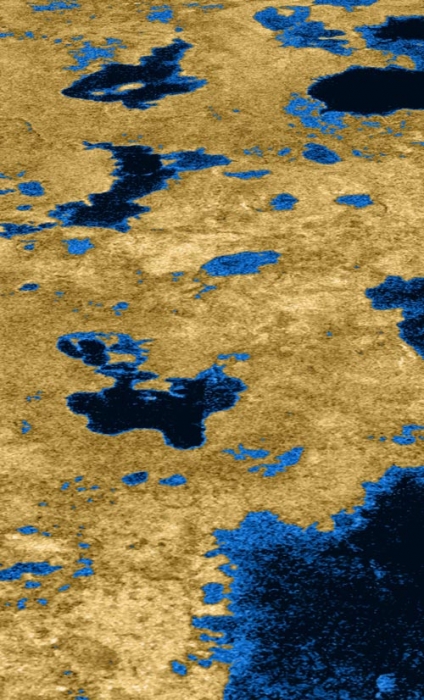
Want to learn more?
Cassini has completed surveying many of Saturn's moons, and, like the Galileo satellite mission to Jupiter, its results have revolutionized our understanding of Saturn's moons. We now have many impressive images of the larger moons of Saturn.
- APOD: Cassini's view of Enceladus -- more recent analyses of Enceladus have discovered giant plumes of water and ice erupting from this Moon, which has led to studies suggesting that it, too, has a subsurface ocean.
- APOD: Cassini's view of Rhea
- APOD: Cassini's view of Iapetus
- APOD: Cassini's view of Dione
- APOD: Cassini's view of Tethys
Saturn does have many small, irregular moons, as well. In the Saturnian system, however, it seems like these moons play an interesting role with regards to the ring system. The gravitational pull of the moons can help keep the rings in narrow, tight orbits (any particle that strays from the ringlet will get ejected or pushed back into the ringlet by the force of gravity from a moon), or they can even clean out gaps in the rings. Here is an image of the moon Prometheus appearing to directly interact with the material in one of Saturn's rings.
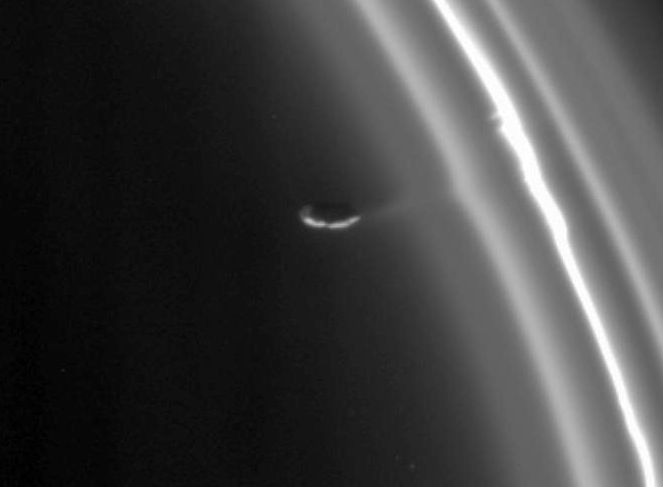
The moons of Uranus and Neptune
The moons of Uranus and Neptune include several that have interesting surface features and properties like several of the larger moons of Jupiter and Saturn. No satellite mission since the Voyager 2 mission has visited these moons, though, so their properties are not as well studied yet as the Galilean satellites and Titan. Below is an image of Triton, a strange moon orbiting Neptune.
Overall, the moons of the Jovian planets are a diverse collection of objects that exhibit a wide set of properties. Many of the moons have been studied in detail by the recent Galileo and Cassini missions, but there is still much more for us to learn.
